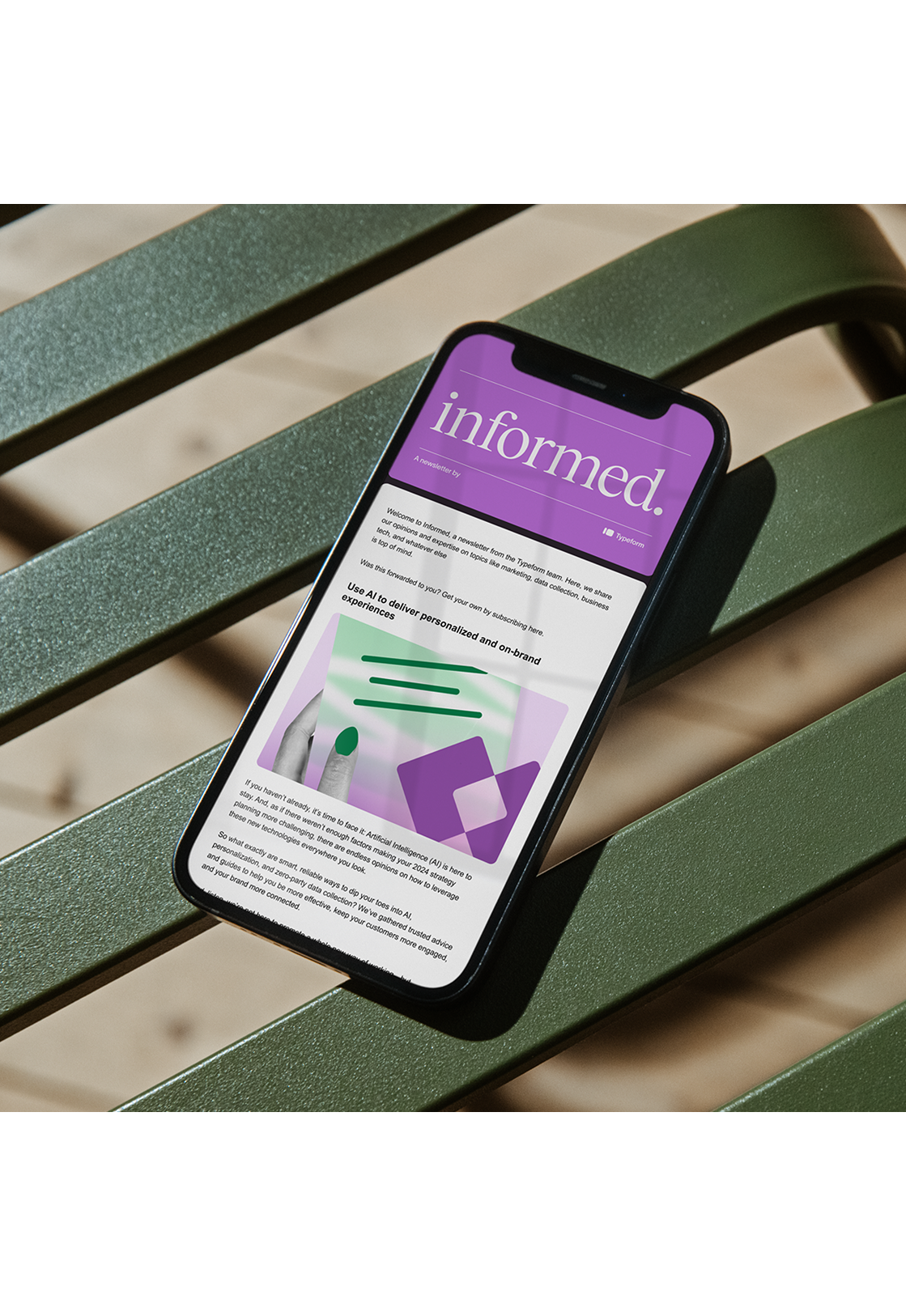How to wrangle a cross-functional marketing campaign—without meeting fatigue
The best campaigns happen when you lead with empathy, not just process.
4 MIN READ

What’s inside?
“Ok class, let’s get into groups.”
Dreaded words.
We might have made it out of high school, but the truth is most “grown-up jobs” are an unending series of one group project after another.
And with those projects come the standard pain points: lack of cohesive vision, communication mix-ups, and uncertainty about who’s doing what. (And who’s doing squat.)
But Meg Clancy, Senior Marketing Programs Manager at Typeform, is a group project optimist.
Her deep background in the marketing multihyphenates—long-term projects, multi-channel campaigns, cross-functional collaboration—lets her see the group project for what it should be: an effort where the total is greater than the sum of its parts.
(That’s how she materializes projects like our massive Get Real report.)
When Meg leads cross-team marketing campaigns, she knows the best outcomes come when you let each player contribute their own ideas, skills, and enthusiasm.
People > process
A common challenge for cross-functional marketing campaigns is establishing a common vision. Marketers balancing input from content, product, sales, PR, legal, and other teams are also balancing different priorities and vocabularies.
“Everbody has their specialist view,” says Meg. “It’s easy to get laser focused on that and lose track of the big picture.”
When everyone is rowing in different directions, you end up with cross-functional campaigns where:
- There isn’t a clear goal to work toward, so it’s harder to make decisions
- The group can’t agree on a clear path forward, so you miss deadlines and push back launch plans
- You can’t get exec buy-in because you don’t understand the vision you’re pitching
- The team has inconsistent expectations about success metrics (what to measure, how, and what to aim for)
- You spend hours in meetings where nothing seems to actually get done
And that’s just in the planning stage. Campaigns always look different out in the real world than they do during planning, and the above issues only compound as campaigns evolve.
“Many campaigns start out as one thing and end as something totally different,” says Meg. “Making sure everybody is along for the ride is a major challenge.”
To solve this, Meg doesn’t ground herself in process alone. She focuses on people.
The key to successful marketing campaigns isn’t more meetings or tighter control. It’s understanding people deeply enough to create the right team structure and communication channels to get things done.
.png)
How to drive a cross-functional campaign (without tearing your hair out)
Step one: Involve everyone at the “ideas” phase
The ideation stage is the stage with the biggest guest list. When you’re early in your planning, bring in all the possible stakeholders to hash out their ideas, objectives, and what success looks like.
“You have to foster an environment where people feel comfortable to speak up,” Meg adds. “It’s a good thing for someone to say, ‘Wait a minute, this doesn’t make sense to me.’” A listening tour where you ask a range of teams about their goals, metrics, capabilities, and hopes for the campaign lets you hear from all the experts.
This stage also helps you create early excitement for the people who will actually execute the campaign.
“People feel more excited to work on something that they feel like they have a stake in,” Meg says. “But it takes a minute to make people feel like they truly have a say in the outcome of the campaign—so you have to set that tone from the beginning.”
Step two: Identify your core team
Once you’ve set an initial vision and everyone has had the chance to speak up, identify who needs to be involved in day-to-day decision making, versus who just needs to stay informed.
Job function alone won’t tell you who will make for a superstar team. “I’m not just looking for people who are here to check a box,” Meg explains. “I want people who ask the ‘why’ questions.”
To identify those people, she asks questions about her teammates like:
- What parts of their job is this person best at?
- What is this person good at outside of their day-to-day job function that might apply here too?
- What makes this person excited?
- Who hasn’t worked on this type of project before, but has expressed interest in trying it?
Your core team should be able to see the big picture—a qualification beyond seniority and job title.
.png)
Step three: Dual communications structure
With the core team identified, establish clear communication rhythms that keep both the core and extended teams aligned without overwhelming anyone.
Meg recommends creating separate communication tracks for core decision-makers (who need frequent in-depth discussions) and informed stakeholders (who want regular updates on decisions and timing).
.png)
As the campaign goes on, the makeup of those two groups might shift. For example, the decision-makers needed to set the campaign strategy and outline content are different from the decision-makers who will finalize design and hit the publish button.
“As the campaign driver, I don’t need to be the one making edits to sentence structure and design in Figma,” says Meg. “You gotta know how to tap people out, because we can’t make decisions when there are 17 opinions working on a single page.”

Step zero: Be kind
If you’ll allow us to travel back in time for a second.
Steps 1–3 only work if they’re built on a foundation of real connection.
“I’ve always worked in super cross-functional roles, so people ask me all the time, ‘How do you make people work together?’” says Meg. “The answer is literally just to be nice to people. Be friendly. Lead with empathy.”
When you get to know people on a human-to-human basis, you’ll see the potential they have beyond their job description, where they can grow, and what projects they get genuinely excited about.
Even in a remote environment, starting a meeting with “normal” conversation (vs. jumping straight to business) can go a long way to building this connection.
“The core of my everyday job is checking in with people about whether they feel good about what they have to do,” says Meg. “I’m not a people manager, but I still view my job as a leadership role. I work to bring people forward into the light, to really show off what they can do and put their skills to good use.”
The whole is greater than the sum of its parts
Meg’s people-first leadership was the steady touch that helped Typeform launch one of Typeform’s our largest marketing campaigns ever: the Get Real report.
It was a massive project that ultimately totalled 1,300 respondents, 500K digital impressions, 1M in-person impressions, and a 5-chapter report of data-backed insights about influencer marketing.
And it worked because everyone had their role to play.
“We needed every single person to weigh in with their expertise to actually make the thing function,” says Meg. “Kay-Kay was super involved with content strategy, and Kevin was our campaign creative director. Lydia actually wrote the report. Dimi designed it. Norma knows everything about influencers, and Maggie wrangles all things social.”
Who knew a group project could be so nice?
The takeaway
Ask me anything
Got a burning question? Ask Meg directly in the typeform below.
Planning your next campaign?
Get tips on what to ask, how to frame it, and how to actually get people to respond.
Want real feedback?
Ask about subject lines, formats, or strategy. Meg's here to help you make it work.

Join almost 50,000 marketers staying informed (for free)
Every week, we’ll share free insights on topics like data collection, marketing, and much more. So, are you ready for a good read?